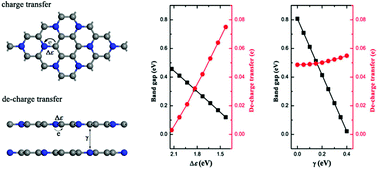Band gap reduction in van der Waals layered 2D materials via a de-charge transfer mechanism†
Abstract
A thickness dependent band gap is commonly found in layered two-dimensional (2D) materials. Here, using a C3N bilayer as a prototypical model, we systematically investigated the evolution of a band gap from a single layer to a bilayer using first principles calculations and tight binding modeling. We show that in addition to the widely known effect of interlayer hopping, de-charge transfer also plays an important role in tuning the band gap. The de-charge transfer is defined with reference to the charge states of atoms in the single layer without stacking, which shifts the energy level and modifies the band gap. Together with band edge splitting induced by the interlayer hopping, the energy level shifting caused by the de-charge transfer determines the size of the band gap in bilayer C3N. Our finding, applicable to other 2D semiconductors, provides an alternative approach for realizing band gap engineering in 2D materials.

- This article is part of the themed collection: Editor’s Choice: van der Waals heterostructures


 Please wait while we load your content...
Please wait while we load your content...
